"Nature" sub -magazine: scientists make pig skin into corneal membranes, so that the blind people can regain their light
Author:Medical community Time:2022.08.17

A cornea made of pork skin collagen allows 14 blind people to regain light.
Written article | Ling Jun, Yan Xiaoliu
Source | "Medical Community" public account
On August 11, in a study released by Nature · Biotechnology, scientists demonstrated a cornea made of pork skin collagen, and thereby restoring 20 conical cornea patients -including 14 patients who have become blind.
This result has brought new hopes for patients with corneal diseases in global corneal diseases through biological engineering implants. As one of the severe blind diseases, according to statistics, about 12.7 million people around the world are blind due to corneal disease, but an average of 70 people can wait for the opportunity of keratin transplantation.
Professor Neil Lagali, the main author of this research, Sweden Lin Xueping University Experimental Ophthalmology, said that the latest developed biomass is expected to meet all the standards of human implants. At the same time, it can be produced on a large scale. Solve the problem of corneal donation shortage.

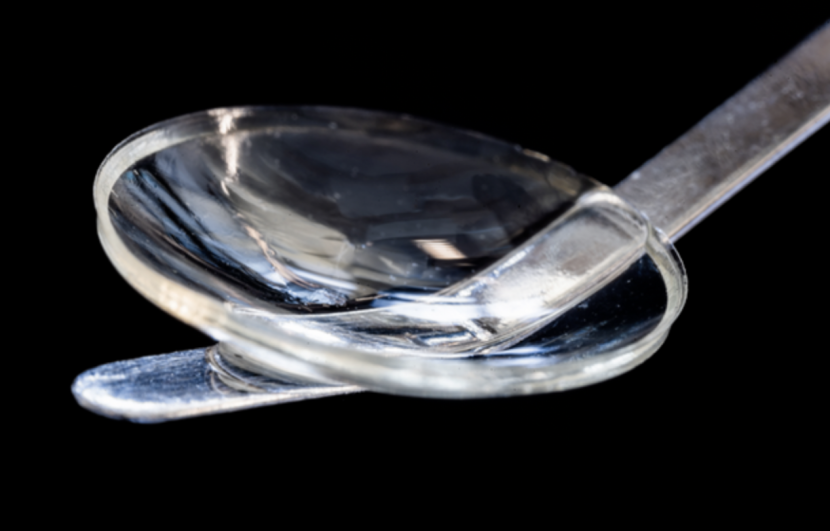
Derived from the cornea of the pig skin
Human cornea is located at the forefront of the eyes, and has the functions that include light transmission, refraction light and protecting pupils, lens and other inner eye structures. The characteristics of the conical cornea are thinning the cornea, losing the natural shape and starting to protruding the cone -shaped, and the abnormal cornea will also affect the vision.
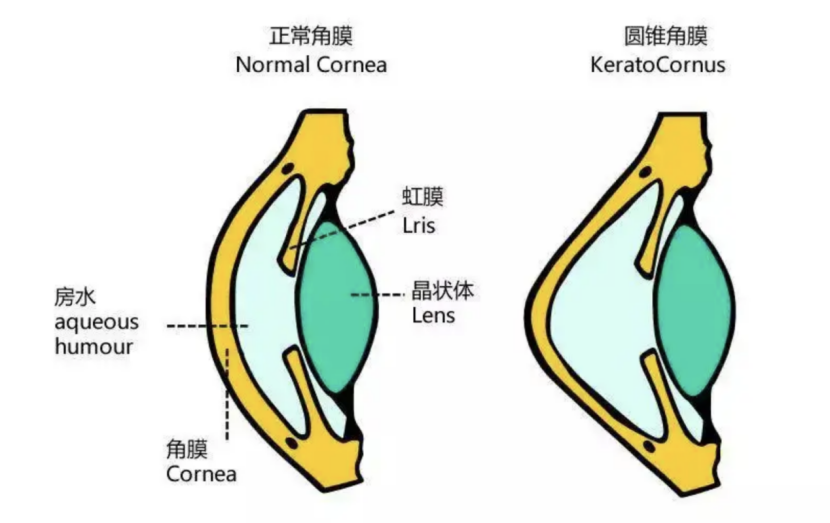
In this study completed by the Biomedical and experimental ophthalmology team of Linding University of Sweden, scientists invented a corneal called BPCDX. They first dissolved the pig skin tissue, extract and purify pig skin collagen, and then enhanced stability through chemical and photochemical methods, forming a solid and transparent hydrogel as a corneal substitution.
As far as the material itself is concerned, its advantage is that the raw material pork skin is easy to obtain and the price is cheap. At the same time, the cornea donated by the human body usually needs to be used within 2 weeks, while BPCDX can be stored for up to 2 years because of the non -cells and the sterile packaging.
The treatment process is also different from the traditional invasive surgery. Doctors do not need to remove the corneal tissue of the patient's original lesion. Instead, the BPCDX is directly implanted and covered with the original cornea through a 2 mm incision.
Director of the Ophthalmology Department of a three -level hospital in Shanghai has analyzed the "medical community" and understands that this artificial cornea is a "lens".
"When using this artificial cornea, doctors only need to cut a small mouth with laser on the corneal of the patient, make a surgical tunnel, and implant the artificial cornea into it. The surgery is completed without suture." He said.
It can be clearly seen through imaging imaging. BPCDX fills the thickness of the loses of the conical cornea, and the corneal curvature is also returned to normal. In addition, BPCDX showed strong anti -degradation in the body. After 2 years of implantation, the human eye remained complete, so that the thickness of the cornea was always maintained.
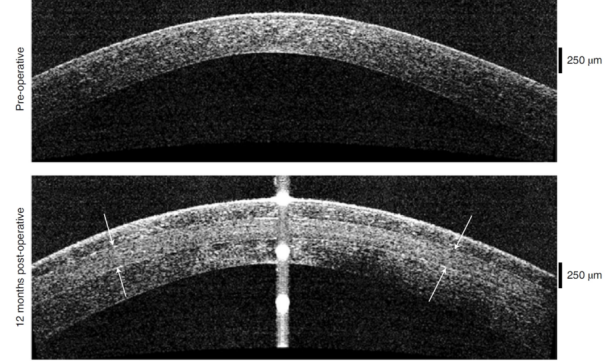
The thickness of the cornea, the arrow indicates the outline (bottom) of the implant BPCDX
3 blind patients' vision returns to 1.0
In order to test the clinical efficacy of BPCDX, scientists have recruited 20 conical corneal patients from Iran and India, of which 14 are blind and 6 are on the verge of blindness.
Two years after the implantation of BPCDX, the central cornea thickness of Iranian patients increased an average of 285 ± 99 µm. The aversion thickness of Indian patients increased an average of 209 ± 18 µm. The patient's correction has been significantly improved.
Specifically, for 8 Indian patients, the average vision of corrected vision was restored to 20/26 (about 0.8), and the average vision of 12 Iranian patients returned to 20/58 (about 0.35). In addition, all 14 blind patients recovered their vision, and three of them had 1.0 corrected vision.

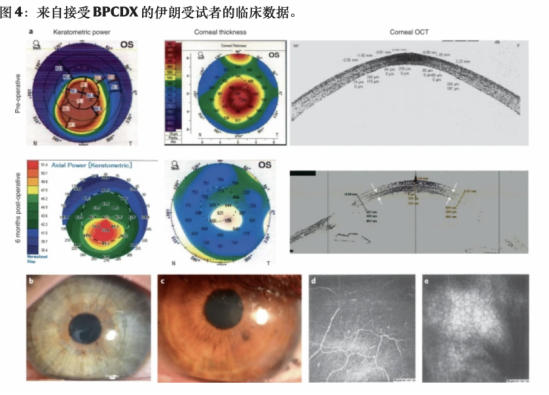
"I remember when I was undergoing the first implant, I slept all night and waited for the surgeon to inform me of the progress of the operation." Professor MEHRDAD RAFAT, one of the researchers, said, "Surprisingly, we get better than expected than expected. A lot of results. "
The results show that the degree of vision improvement after BPCDX implantation has reached the same level as accepting corneal transplantation of human eye. But in comparison, traditional corneal transplantation, patients need to take immunosuppressive drugs for several years. "But the risk of this kind of implantation from pig skin is very low, because collagen is a protein composed of amino acids without any cells." Researchers said.
After the operation, the 20 patients only used an immunosuppressive eye drops for 8 weeks. No rejection reaction was observed during the 2 -year follow -up, and no scars or inflammation occurred.
In the next step, Professor Neil Lagali and the team plan to copy the results of the research among 100 or more patients, so that the BPCDX is approved by the government. Scarce areas.
"This is a very good product." The aforementioned ophthalmology director evaluated the "medical community". It can achieve large -scale mass production, no rejection problem, smaller implantation into the wound, and relatively simple minimally invasive surgical methods, all of which are its advantages.
But the defect is that the patient group that can be applied by BPCDX may still be very limited. "The cornea of patients with conical cornea has no lesions, but there is a deformation. For patients with other corneal diseases, this artificial cornea may not be applicable. The transplant materials to be used after corneal lesions are different, and some patients need to remove the full layer to remove the entire layer Corner, changing a new cornea, "he said. Researchers also said that follow -up will continue to explore whether the technology can be used to treat more eye diseases and increase individual adaptability to obtain greater curative effects.
references:
[1]Eye implant made from pig skin restored sight in blind people, according to study,https://globalnews.ca/news/9055629/pig-skin-cornea-implants-blindness-study/[2]Cornea made from pig Collagen Gives People Who Wee Blind 20/20 Vision, https://www.newscientist.com/article/2333290-cornea-from-Pig-Collagues-PEOPLE-WHO-BLIND-VIND-20-20-20-20-20-20-20-20-20-20-20-20-20-20 / /
[3]Could THIS be the way to reverse blindness? Pioneering cornea implant made from PIG'S SKIN restores sight in 20 visually-impaired people in promising trial,https://www.dailymail.co.uk/sciencetech/article-11105183/Cornea -IMPLANT-PIGS-SKIN-RESTORES-SIGHT-20-Visually-IMPAIRED-PEOPLE-PROMISISING-TRIAL.HTML
Source: Medical Community
Responsible editor: Tian Dongliang
- END -
Heilongjiang Provincial Bank of Development Bank this year's first travel train

Yichun is picturesque, Lindujia is in the world. On July 9th, Y693 travelers set o...
China Sports Lottery July 16th results
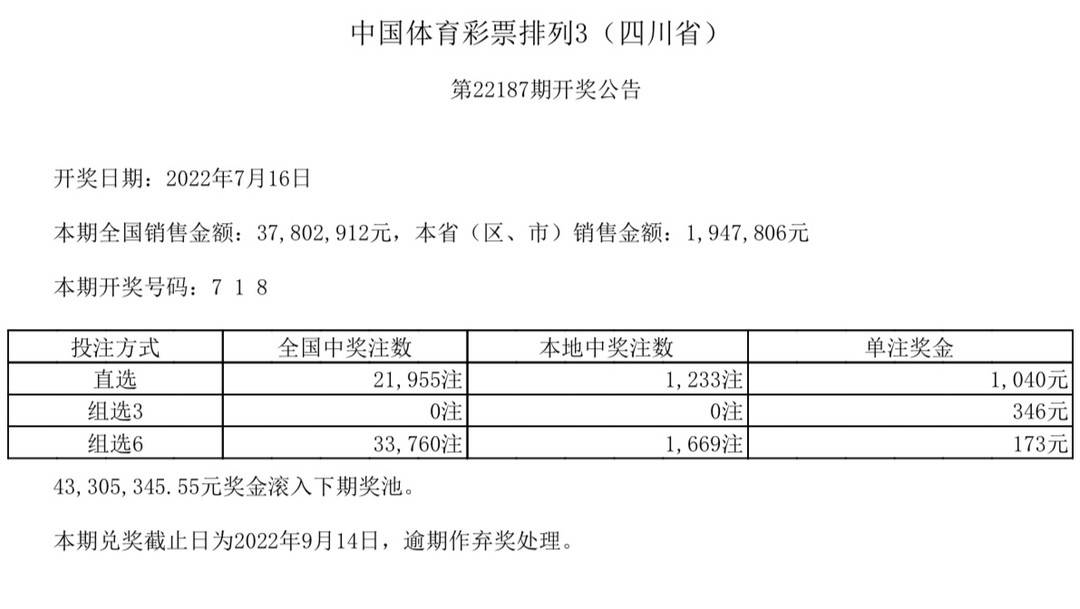
China Sports Lottery Over 37802912 yuan in the 22187th issue.Lottery number: 7 1 8...